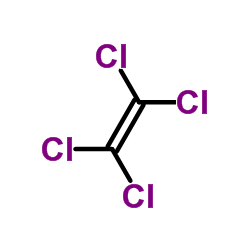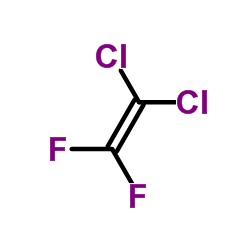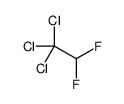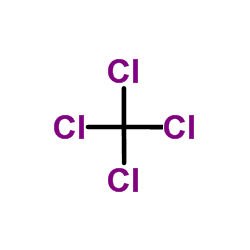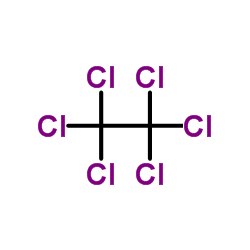76-11-9
| 中文名 | 1,1,1,2-四氯-2,2-二氟乙烷 |
|---|---|
| 英文名 | 1,1-difluorotetrachloroethane |
| 中文别名 |
2,2-二氟四氯乙烷
2,2-二氟-5-氨基-6-氯-1,3-苯并二噁唑 OZONE DEPLETING 1,1-二氟-1,2,2,2-四氯乙烷 |
| 英文别名 |
1-chloro-1,1-difluoro-2,2,2-trichloro-ethane
f112a tetrachlorodifluoroethane 1,1-difluoro-1,2,2,2-tetrachloroethane MFCD00000798 Fron-112a freon112a tetrachloro-2,2-difluoroethane 2,2-DIFLUORO-5-AMINO-6-CHLORO-1,3-BENZODIOXOLE cfc112a Genetron131 EINECS 200-934-0 1,1,1,2-tetrachloro-2,2-difluoroethane 1,1-difluoro-tetrachloroethane Freon BU difluorotetrachloroethane refrigerant112a r112a halocarbon112a |
| 密度 | 1.726 g/cm3 |
|---|---|
| 沸点 | 93.3ºC at 760 mmHg |
| 熔点 | 39-44ºC |
| 分子式 | C2Cl4F2 |
| 分子量 | 203.83000 |
| 闪点 | 11.8ºC |
| 精确质量 | 201.87200 |
| LogP | 3.18820 |
| 外观性状 | 无色结晶固体 |
| 折射率 | 1.4046 |
| 储存条件 | 本品密封阴凉干燥保存。 |
| 分子结构 | 1、 摩尔折射率:30.97 2、 摩尔体积(m3/mol):118.0 3、 等张比容(90.2K):274.6 4、 表面张力(dyne/cm):29.2 5、 极化率(10 -24cm 3):12.27 |
| 计算化学 | 1、 疏水参数计算参考值(XlogP):3.4 2、 氢键供体数量:0 3、 氢键受体数量:2 4、 可旋转化学键数量: 0 5、 互变异构体数量: 6、 拓扑分子极性表面积(TPSA):0 7、 重原子数量:8 8、 表面电荷:0 9、 复杂度:84.5 10、 同位素原子数量:0 11、 确定原子立构中心数量:0 12、 不确定原子立构中心数量:0 13、 确定化学键立构中心数量:0 14、 不确定化学键立构中心数量:0 15、 共价键单元数量:1 |
| 更多 | 1. 性状:不确定 2. 密度(g/mL,25/4℃):(20/4℃)1.65 3. 相对蒸汽密度(g/mL,空气=1):不确定 4. 熔点(ºC):38-40℃ 5. 沸点(ºC,常压):91℃ 6. 沸点(ºC,5.2kPa):不确定 7. 折射率:不确定 8. 闪点(ºC):不确定 9. 比旋光度(º):不确定 10. 自燃点或引燃温度(ºC):不确定 11. 蒸气压(kPa,25ºC):不确定 12. 饱和蒸气压(kPa,60ºC):不确定 13. 燃烧热(KJ/mol):不确定 14. 临界温度(ºC):不确定 15. 临界压力(KPa):不确定 16. 油水(辛醇/水)分配系数的对数值:不确定 17. 爆炸上限(%,V/V):不确定 18. 爆炸下限(%,V/V):不确定 19. 溶解性:不确定 |
Synonym:1,1,1,2-Tetrachloro-2,2-Difluoroethane; Halocarbon 112 Section 2 - COMPOSITION, INFORMATION ON INGREDIENTS
Risk Phrases: None Listed. Section 3 - HAZARDS IDENTIFICATION EMERGENCY OVERVIEW
Not available. Potential Health Effects Eye: May cause eye irritation. Skin: May cause skin irritation. Ingestion: May cause irritation of the digestive tract. Inhalation: Vapor reduces oxygen available for breathing. May cause respiratory tract irritation. Chronic: No information found. Section 4 - FIRST AID MEASURES Eyes: Flush eyes with plenty of water for at least 15 minutes, occasionally lifting the upper and lower eyelids. If irritation develops, get medical aid. Skin: Flush skin with plenty of water for at least 15 minutes while removing contaminated clothing and shoes. Get medical aid if irritation develops or persists. Wash clothing before reuse. Ingestion: Never give anything by mouth to an unconscious person. Do NOT induce vomiting. If conscious and alert, rinse mouth and drink 2-4 cupfuls of milk or water. Wash mouth out with water. Get medical aid if irritation or symptoms occur. Inhalation: Remove from exposure and move to fresh air immediately. If not breathing, give artificial respiration. If breathing is difficult, give oxygen. Get medical aid if cough or other symptoms appear. Notes to Physician: Section 5 - FIRE FIGHTING MEASURES General Information: As in any fire, wear a self-contained breathing apparatus in pressure-demand, MSHA/NIOSH (approved or equivalent), and full protective gear. During a fire, irritating and highly toxic gases may be generated by thermal decomposition or combustion. Extinguishing Media: Use agent most appropriate to extinguish fire. Use water spray, dry chemical, carbon dioxide, or appropriate foam. Section 6 - ACCIDENTAL RELEASE MEASURES General Information: Use proper personal protective equipment as indicated in Section 8. Spills/Leaks: Vacuum or sweep up material and place into a suitable disposal container. Clean up spills immediately, observing precautions in the Protective Equipment section. Avoid generating dusty conditions. Provide ventilation. Section 7 - HANDLING and STORAGE Handling: Wash thoroughly after handling. Wash hands before eating. Remove contaminated clothing and wash before reuse. Minimize dust generation and accumulation. Avoid contact with eyes, skin, and clothing. Keep container tightly closed. Avoid ingestion and inhalation. Use with adequate ventilation. Storage: Store in a tightly closed container. Store in a cool, dry, well-ventilated area away from incompatible substances. Section 8 - EXPOSURE CONTROLS, PERSONAL PROTECTION Engineering Controls: Facilities storing or utilizing this material should be equipped with an eyewash facility and a safety shower. Use adequate ventilation to keep airborne concentrations low. Exposure Limits CAS# 76-11-9: United States OSHA: 500 ppm TWA; 4170 mg/m3 TWA Belgium - TWA: 500 ppm VLE; 4231 mg/m3 VLE France - VME: 500 ppm VME; 4170 mg/m3 VME Germany: 1000 ppm TWA; 8500 mg/m3 TWA Malaysia: 500 ppm TWA; 4170 mg/m3 TWA Netherlands: 500 ppm MAC; 4170 mg/m3 MAC Personal Protective Equipment Eyes: Wear appropriate protective eyeglasses or chemical safety goggles as described by OSHA's eye and face protection regulations in 29 CFR 1910.133 or European Standard EN166. Skin: Wear appropriate protective gloves to prevent skin exposure. Clothing: Wear appropriate protective clothing to prevent skin exposure. Respirators: Follow the OSHA respirator regulations found in 29 CFR 1910.134 or European Standard EN 149. Use a NIOSH/MSHA or European Standard EN 149 approved respirator if exposure limits are exceeded or if irritation or other symptoms are experienced. Section 9 - PHYSICAL AND CHEMICAL PROPERTIES Physical State: Powder Color: white Odor: none reported pH: Not available. Vapor Pressure: Not available. Viscosity: Not available. Boiling Point: 91 deg C @ 760.00mm Hg Freezing/Melting Point: 41 deg C Autoignition Temperature: Not applicable. Flash Point: Not applicable. Explosion Limits, lower: Not available. Explosion Limits, upper: Not available. Decomposition Temperature: Solubility in water: insoluble Specific Gravity/Density: 1.6490g/cm3 Molecular Formula: C2Cl4F2 Molecular Weight: 203.83 Section 10 - STABILITY AND REACTIVITY Chemical Stability: Stable. Stable under normal temperatures and pressures. Conditions to Avoid: Incompatible materials, dust generation, excess heat, strong oxidants. Incompatibilities with Other Materials: Strong acids, strong bases, strong oxidizing agents. Hazardous Decomposition Products: Hydrogen chloride, carbon monoxide, irritating and toxic fumes and gases, carbon dioxide, hydrogen fluoride gas. Hazardous Polymerization: Has not been reported Section 11 - TOXICOLOGICAL INFORMATION RTECS#: CAS# 76-11-9: KI1425000 LD50/LC50: CAS# 76-11-9: Inhalation, mouse: LC50 = 123000 mg/m3/2H; Inhalation, rat: LC50 = 125000 mg/m3/4H; Oral, rat: LD50 = >8 gm/kg. Carcinogenicity: 1,1,1,2-Tetrachloro-2,2-Difluoroethane - Not listed by ACGIH, IARC, or NTP. Other: See actual entry in RTECS for complete information. Section 12 - ECOLOGICAL INFORMATION Section 13 - DISPOSAL CONSIDERATIONS Dispose of in a manner consistent with federal, state, and local regulations. Section 14 - TRANSPORT INFORMATION IATA Not regulated as a hazardous material. IMO Not regulated as a hazardous material. RID/ADR Not regulated as a hazardous material. Section 15 - REGULATORY INFORMATION European/International Regulations European Labeling in Accordance with EC Directives Hazard Symbols: Not available. Risk Phrases: Safety Phrases: S 24/25 Avoid contact with skin and eyes. S 28A After contact with skin, wash immediately with plenty of water. S 37 Wear suitable gloves. S 45 In case of accident or if you feel unwell, seek medical advice immediately (show the label where possible). WGK (Water Danger/Protection) CAS# 76-11-9: No information available. Canada CAS# 76-11-9 is listed on Canada's NDSL List. CAS# 76-11-9 is listed on Canada's Ingredient Disclosure List. US FEDERAL TSCA CAS# 76-11-9 is listed on the TSCA inventory. SECTION 16 - ADDITIONAL INFORMATION N/A |
|
毒理学数据: 1、急性毒性 大鼠口径LD50:>8mg/kg 大鼠吸入LC50: 20000PPM/30m CHEMICAL IDENTIFICATION
HEALTH HAZARD DATAACUTE TOXICITY DATA
|
| 危害码 (欧洲) | N: Dangerous for the environment;Xi: Irritant; |
|---|---|
| 风险声明 (欧洲) | R59;R36/37/38 |
| 安全声明 (欧洲) | S59-S37/39-S26 |
| 上游产品 9 | |
|---|---|
| 下游产品 10 | |




